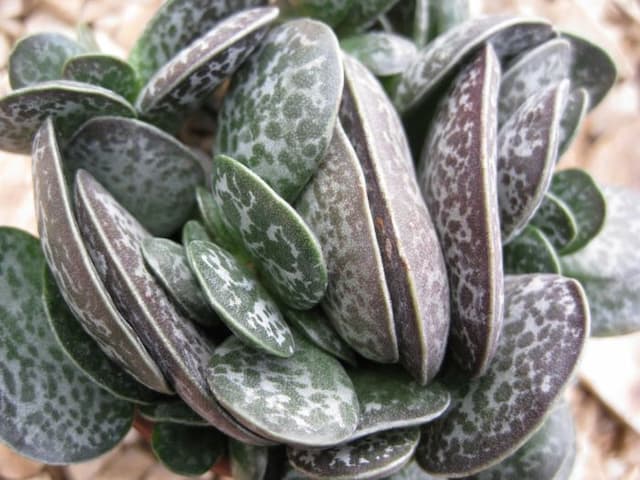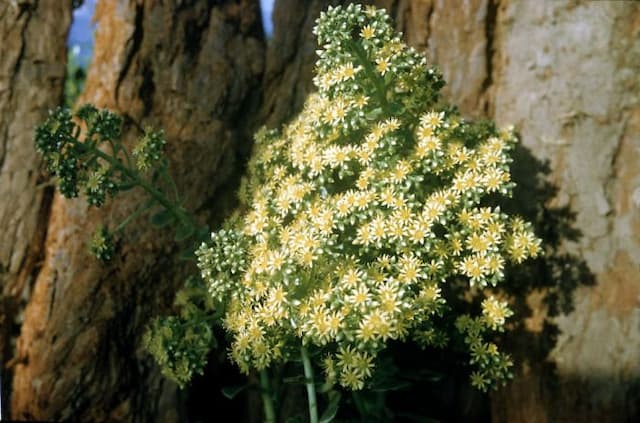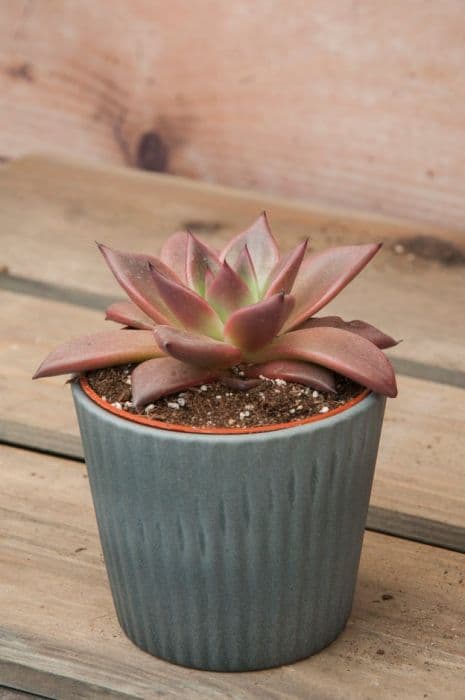Saucer Plant Aeonium undulatum

ABOUT
The Aeonium undulatum, commonly known as Saucer Plant, is an attractive succulent with a striking appearance. It forms rosettes of fleshy, spoon-shaped leaves that are bright green in color. The leaves are often wavy or curled, giving the plant a unique and undulating texture that is pleasing to the eye. These rosettes grow in a rounded, compact shape that adds to the decorative appeal of the plant. The Saucer Plant's leaves are smooth and glossy, with a succulent texture that allows it to retain water, making it drought-tolerant and able to thrive in sunny, dry environments. The leaf margins may show a hint of red or purple, especially when the plant is exposed to cool temperatures or bright sunlight, adding a slight contrast to the predominantly green foliage. During its blooming period, the Saucer Plant produces conical clusters of small, star-shaped flowers. These flowers are typically a shade of yellow or sometimes light green, providing a complimentary burst of color against the green foliage. The flowers emerge on tall stalks above the rosettes, creating an eye-catching display. Overall, the Saucer Plant's aesthetic is one of architectural interest and natural beauty, which makes it a popular choice for rock gardens, Mediterranean-themed landscapes, and as a potted specimen in outdoor patios or indoor spaces with ample light. Its resilience and distinctive wavy leaf formation have earned it admiration among gardeners and succulent enthusiasts alike.
About this plant
 Names
NamesFamily
Crassulaceae
Synonyms
Saucer Plant
Common names
Sempervivum undulatum.
 Toxicity
ToxicityTo humans
Aeonium undulatum, commonly known as Saucer Plant, is generally considered non-toxic to humans. However, as with any plant material, individual sensitivities can vary. Ingesting this plant should not cause poisoning, but if plant parts are consumed in large quantities, there could be a risk of stomach upset or discomfort due to the fibrous material. Always exercise caution and keep plants out of the reach of small children who may accidentally ingest plant parts.
To pets
Saucer Plant is not known to be toxic to pets. However, it is always advisable to prevent pets from ingesting plants. If a pet consumes part of a Saucer Plant, they may experience mild gastrointestinal upset, such as vomiting or diarrhea, especially if consumed in large quantities. Always monitor your pets around houseplants and consult a veterinarian if any unusual symptoms occur after ingestion.
 Characteristics
CharacteristicsLife cycle
Perennials
Foliage type
Evergreen
Color of leaves
Green
Flower color
Yellow
Height
2 feet (60 cm)
Spread
2 feet (60 cm)
Plant type
Succulent
Hardiness zones
9
Native area
Canary Islands
Benefits
 General Benefits
General Benefits- Ornamental appeal: The Aeonium undulatum, commonly known as Saucer Plant, has rosettes of wavy-edged leaves that provide an aesthetic addition to gardens and homes.
- Drought tolerance: This succulent is well-suited for xeriscaping and can thrive with minimal water, making it a great choice for water-wise gardeners.
- Easy propagation: Saucer Plant can be easily propagated from cuttings, which allows gardeners to expand their collection without additional cost.
- Low maintenance: It requires very little care, neither demanding regular fertilization nor pruning, which is ideal for busy plant owners.
- Long lifespan: As a perennial, the Saucer Plant can live for many years, offering long-term enjoyment.
- Seasonal interest: The Saucer Plant produces impressive cone-shaped inflorescences of yellow flowers that add seasonal interest to the garden.
- Attracts pollinators: The flowers of the Saucer Plant can attract bees and other pollinating insects, supporting local ecosystems.
- Adaptability: It can grow in a variety of soil types, as long as there is good drainage, making it suitable for different garden conditions.
- Container gardening: Due to its moderate size and root system, it is well-suited for growing in pots, allowing for flexibility in garden design and space utilization.
- Architectural structure: With its distinctive form, the Saucer Plant can serve as an architectural element within a garden or as a focal point in a collection of plants.
 Medical Properties
Medical PropertiesThis plant is not used for medical purposes.
 Air-purifying Qualities
Air-purifying QualitiesThis plant is not specifically known for air purifying qualities.
 Other Uses
Other Uses- Aeonium undulatum is often used as a living sculpture in gardens or patios, due to its large rosettes and wavy leaves that add an artistic touch.
- This plant can be employed as a natural barrier or edging in landscaping because of its dense and compact growth habit.
- In coastal areas, Aeonium undulatum is utilized to stabilize soil and prevent erosion because it can withstand strong winds and salty air.
- This species is ideal for creating a dramatic visual impact in xeriscaped gardens, needing minimal water once established.
- Aeonium undulatum can be used in educational settings such as botanic gardens to teach about succulent plant adaptation and conservation.
- This plant is suitable for rooftop gardens where its drought resistance helps to reduce the need for watering infrastructure.
- Enthusiasts of miniature and fairy gardens use Aeonium undulatum for its interesting texture and structure, adding a touch of the fantastical.
- This succulent is often featured in container gardens, being a focal point due to its sizable and sculptural rosettes.
- It can be used as a natural ground cover in areas with mild climates, providing year-round greenery with minimal maintenance.
- The cuttings of Aeonium undulatum are popular in floral arrangements, adding a unique and long-lasting element to bouquets.
Interesting Facts
 Feng Shui
Feng ShuiThe Aeonium is not used in Feng Shui practice.
 Zodiac Sign Compitability
Zodiac Sign CompitabilityThe Aeonium is not used in astrology practice.
 Plant Symbolism
Plant Symbolism- Resilience - Aeonium undulatum, also known as "Saucer Plant," often grows in harsh, rocky environments, symbolizing the ability to thrive in difficult conditions.
- Uniqueness - With its distinctive rosettes and wavy leaves, the Saucer Plant speaks to the unique beauty and individuality found in nature.
- Eternal life - As a succulent, the Saucer Plant is adept at retaining water and enduring long periods without rain, representing longevity and immortality.
- Adaptability - The ability of this plant to adapt to various lighting conditions suggests a symbolic meaning of versatility and flexibility in life.
 Water
WaterThe Saucer Plant, also known as Aeonium undulatum, should be watered thoroughly once the top inch of soil feels dry to the touch, which typically means watering approximately every 7 to 10 days during the active growth period in spring and summer. In the winter, when the plant is dormant, you should reduce watering to every three to four weeks. When you do water, ensure you're providing enough water to soak the soil, but never let the plant sit in water as this can cause root rot. On average, use about 16-32 ounces of water per watering session, depending on the size of the pot and the environmental conditions.
 Light
LightThe Saucer Plant thrives in bright, indirect light, although it can tolerate some direct sunlight, especially in the cooler mornings or late afternoons. An east or west-facing window that receives a few hours of mild direct sun and bright indirect light for the rest of the day is an ideal spot for this plant. Avoid placing it in prolonged direct midday sunlight, as this could scorch the leaves.
 Temperature
TemperatureThe Saucer Plant does best in temperatures ranging between 65 to 75 degrees Fahrenheit during the day and should not be exposed to temperatures below 50 degrees Fahrenheit at night, as it can be damaged by frost. The ideal temperature range facilitates healthy growth and flowering. Make sure to keep it away from cold drafts in winter and extreme heat in summer.
 Pruning
PruningPrune the Saucer Plant to remove any damaged or spent leaves and to shape the plant if desired. This is best done in spring just before the new growth starts. Pruning once a year is often sufficient, as over-pruning can stress the plant.
 Cleaning
CleaningAs needed
 Soil
SoilSaucer Plant prefers well-draining soil mix with a pH around 6.0. A recipe including potting mix, perlite or coarse sand, and peat or coco coir in equal parts works well to replicate its preferred habitat. Regular cactus mix can also be suitable for Aeonium undulatum.
 Repotting
RepottingSaucer Plants should be repotted every 2-3 years or when outgrown their container. It's best to repot in spring or early summer during their active growth period. Ensure fresh, well-draining soil is used to support the plant's health.
 Humidity & Misting
Humidity & MistingSaucer Plant thrives best in moderate humidity levels. Ideal humidity range for Aeonium undulatum is between 40% and 60%. They can adapt to lower humidity typical in home environments but avoid extremely dry air.
 Suitable locations
Suitable locationsIndoor
Provide bright light, well-draining soil, and sparse watering indoors.
Outdoor
Place in bright light, use well-draining soil, and protect from frost.
Hardiness zone
9-11 USDA
 Life cycle
Life cycleAeonium undulatum, commonly known as Saucer Plant, starts its life as a seed that germinates in well-draining soil with sufficient warmth and light. As a seedling, it develops fleshy leaves in a rosette pattern, characteristic of the Aeonium genus, and requires consistent moisture to establish a robust root system. As it matures into a vegetative state, the rosette grows larger, and the plant may produce offsets or "pups" which can be separated to propagate new plants. The Saucer Plant undergoes a vegetative growth period which can last several years, during which it stores water and nutrients in its succulent leaves to endure arid conditions. Once it reaches maturity, Aeonium undulatum produces a tall flowering stalk bearing clusters of yellow, star-shaped flowers, usually in the spring or early summer. After flowering, which is the culmination of its life cycle, the plant often enters a period of dormancy or may die, leaving the offsets to continue its lineage.
 Propogation
PropogationPropogation time
Spring-Early Summer
A popular method of propagation for Aeonium undulatum, commonly known as Saucer Plant, is stem cuttings. During the spring or early summer when the plant is actively growing, a healthy stem can be selected for cutting. The chosen stem should be cut with a sharp, sterile knife or scissors, leaving a length of about 2 to 4 inches (5 to 10 centimeters). The cut end should then be allowed to dry and callous over for a few days to prevent rot when planted. Once the end is calloused, the cutting can be planted in well-draining soil and watered sparingly until it has established roots. It is important to provide bright, indirect light and avoid overwatering to facilitate the growth of the new plant.









